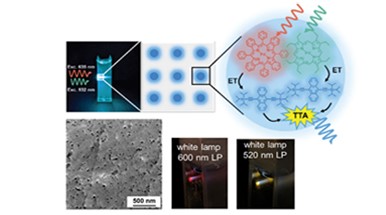
Sensitized triplet–triplet annihilation photon upconversion (sTTA-UC) allows blue-shifting non-coherent low-intensity light and is potentially useful in solar-powered devices, bioimaging, 3D printing, and other applications. For technologically viable solar energy harvesting systems, solid materials that capture a large fraction of the solar spectrum and efficiently upconvert the absorbed energy must be developed.
In the article “Confinement-Enhanced Multi-Wavelength Photon Upconversion Based on Triplet–Triplet Annihilation in Nanostructured Glassy Polymers”, DOI: 10.1002/advs.202415160, published by Advanced Science (Wiley, Impact Factor 14.3, Clarivate Analytics, 2023), Dr. Luca Pollice, Dr. Marco Roccanova, Dr. Alessandra Ronchi, Prof. Michele Mauri and Prof. Angelo Monguzzi of the Department of Materials Science, in collaboration with the Adolphe Merkle Institute and the University of Fribourg (CH), developed nanostructured, multiphase and air tolerant polymers for solid state sensitized triplet–triplet annihilation photon upconversion (sTTA-UC). The confinement of two triplet sensitizers and one triplet annihilator/emitter in nanosized liquid domains renders the various bimolecular energy transfer processes that are pivotal for the TIPS-Ac's triplet sensitization highly efficient, with an enlarged absorption bandwidth up to 150 nm. The UC process at low power densities is most efficient when both sensitizers are simultaneously excited, thanks to their confinement in the nanodroplets that boost the TTA rate and yield optimizing the use of the harvested energy.